Diversity, equity, and inclusion are among the most critical HR trends. At the same time, planning DEI initiatives, creating a solid strategy and measuring its impact takes time and effort.
In this post, we share insights on how to build effective DEI initiatives based on organizational data. We focus on the action steps to increase DEI in the organization, paying attention to the measures that are helpful to spot and track DEI issues that need to be addressed.

Steps in creating DEI initiatives
Diversity, equity, and inclusion are complex to deal with.
First, people differ from each other in many ways. Organizations usually focus on demographics, such as gender, age, or ethnicity. But diversity can be also about personality (for example, extroversion vs introversion), or cognitive characteristics (for example, learning styles or approaches to problem-solving).
Second, the degree of employee diversity results from a constellation of factors that may be difficult to uncover.
Finally, some of these factors, such as those related to our unconscious bias or to a broader social problem, can be hard to change.
For this reason, you should develop DEI initiatives following a process that includes several phases: analyzing available information, identifying challenges and areas of improvement, planning and implementing a solution, and assessing its effectiveness. We can summarise this process in five action steps:
- Collecting and analyzing data
- Defining the problem
- Designing the DEI strategy
- Implementing the DEI initiatives
- Evaluating the outcomes
Below we describe the five action steps in more detail.
1. Collect and analyze data
To develop an effective DEI strategy, you first need to understand what are the areas of improvement. Looking at your organizational data is a good starting point.
DEI is a broad topic that affects all the stages of the employee life cycle. For this reason, you should consider data from different sources: ATS, HRIS, and surveys. You may be wondering what are the best KPIs to inform your DEI strategy, so here are some examples of metrics that you can use, for each of the DEI segments.
Diversity
Start the data analysis by understanding employee diversity: what is the workforce composition in your organization?
Distribution metrics
You can use distribution metrics, which are basic diversity indicators. Distribution metrics are typically used for demographic data, such as gender, or age:
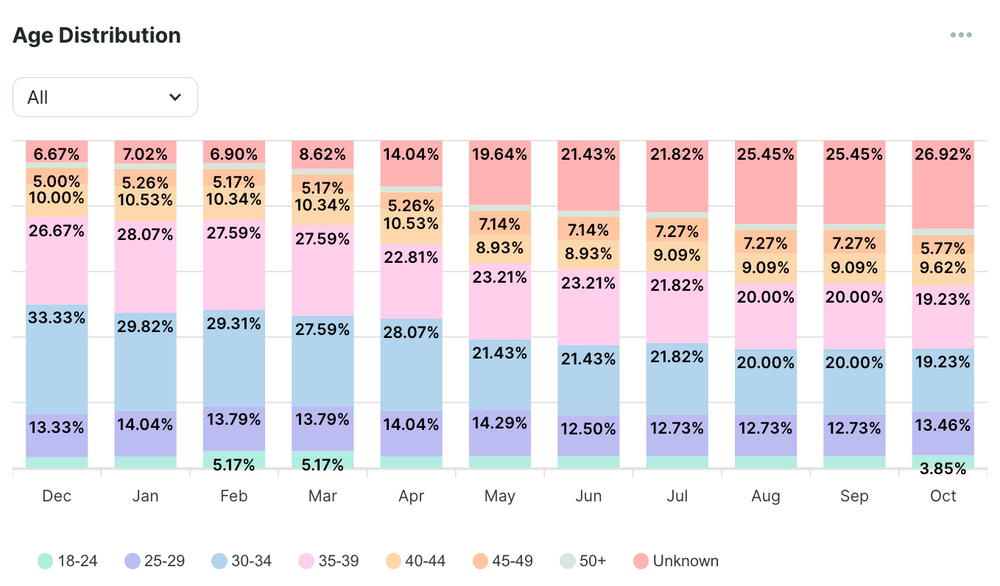
You can also look at other employee characteristics such as personality or cognitive diversity. For example, it is useful to know the distribution of introverts and extroverts in your team, so you can understand and address their specific needs or working styles and help them thrive.
Women in Leadership
Once you have a general idea about diversity in your organization, you can analyze the workforce composition more in detail, estimating the proportion of different groups of employees in specific roles or job levels. For instance, you can calculate the proportion of women in managerial positions:
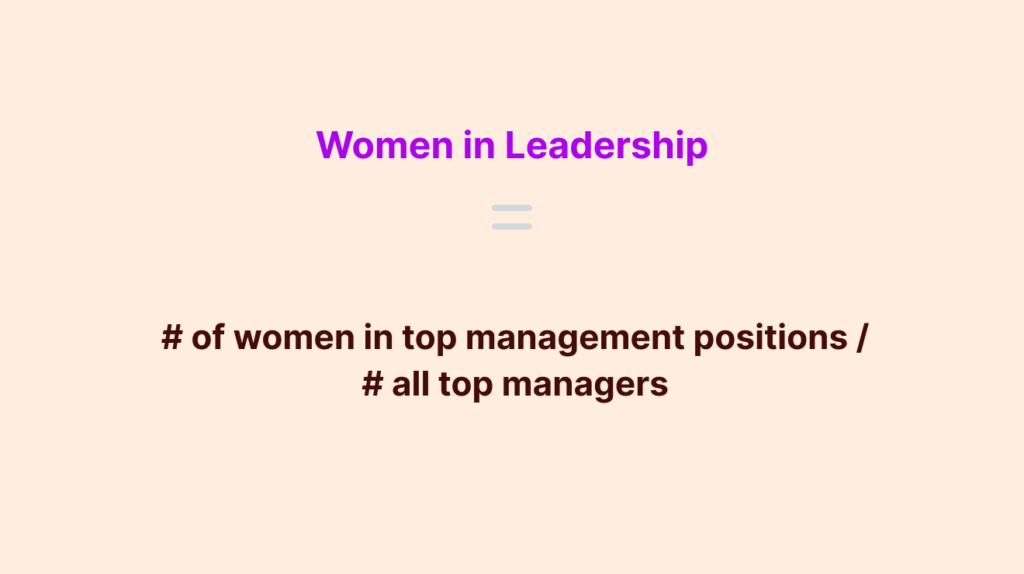
Adjust and use this formula for different minorities, roles, departments, divisions, and so forth.
Pipeline Diversity Ratios
You can also check how diverse is your applicant pool using pipeline diversity ratios. Here is an example of how to calculate pipeline diversity ratios for gender:
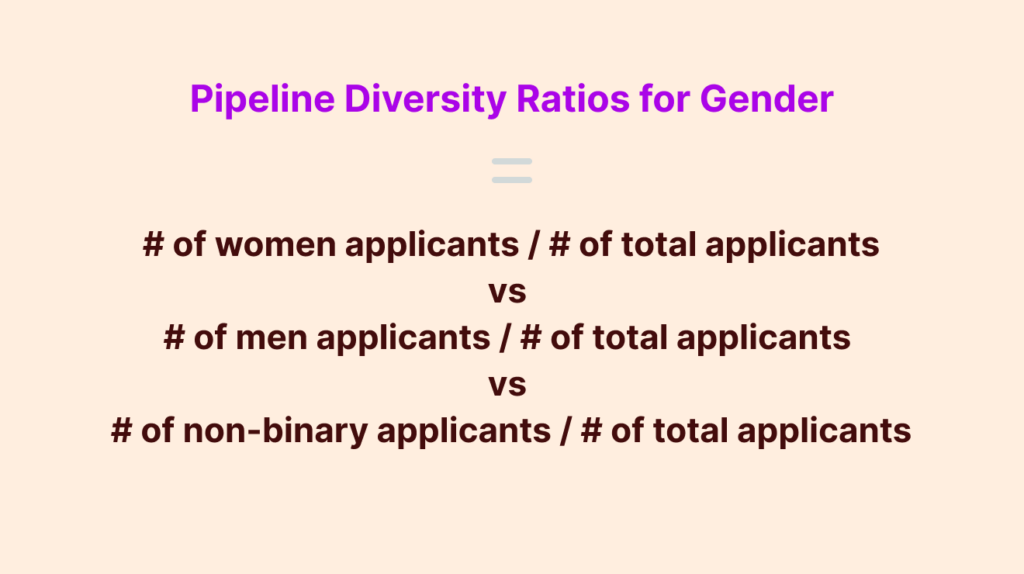
Equity
An imbalanced workforce composition is alarming, but it does not always mean that your DEI efforts fail. You can expect a stronger disproportion in jobs that for years have been typical for one gender, or in regions that are ethnically homogenous. Also, you can’t take for granted that a balanced proportion of women and men, or minority groups, is equal to a successful DEI strategy. Besides checking the workforce distribution, it is crucial to analyze if all the employees in your organization receive equitable treatment and opportunities.
The first thing to do is check whether any groups are affected in decision-making, for example, in hiring or promoting. Use the metrics that give insights about moving people from one stage of the employee life cycle to another.
Hiring Funnel Conversion Ratios
To improve DEI in hiring, you can track Hiring Funnel Conversion Ratios. Using this metric, you can compare what part of applicants that belong to a specific group progressed to the next stage of the selection process. For instance, you can compare female and male applicants taken from the screening stage to the interview stage.
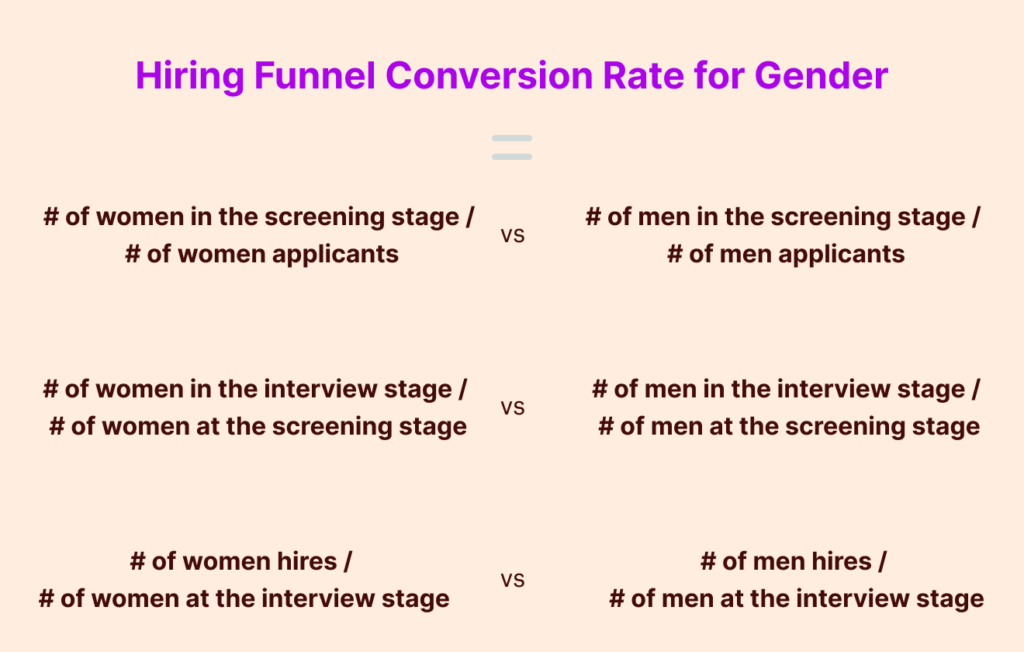
Promotion Rates
Similarly, you can use Promotion Rates to track whether the employees from underrepresented groups are promoted as often as the rest. For example, you can calculate what part of all promoted employees belongs to a certain racial group:
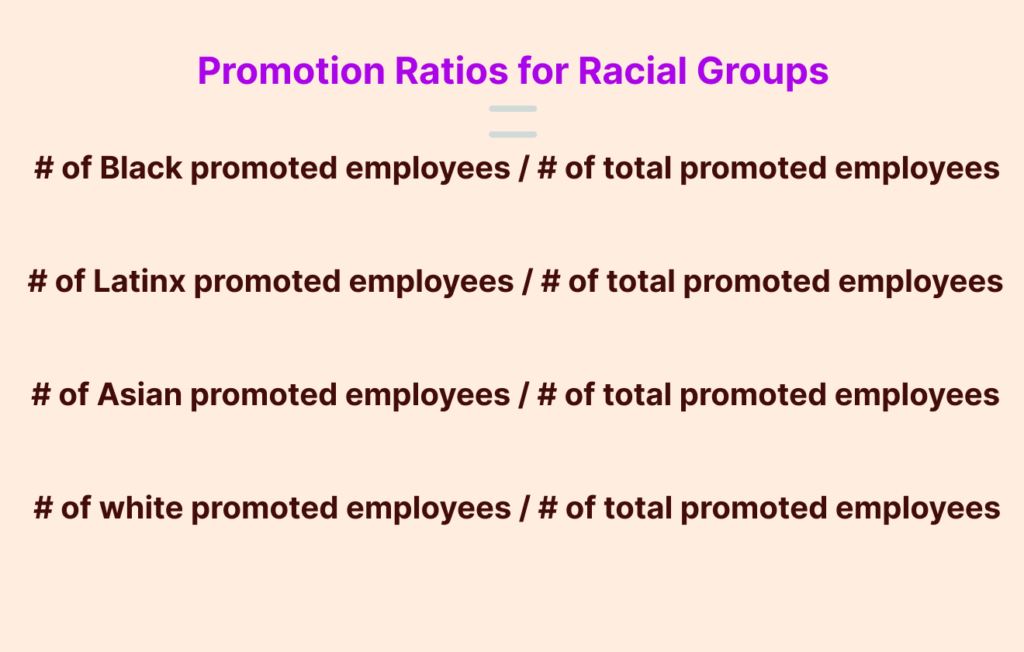
To get richer insights about promotions, analyze Employee Movement Rate and Time to Promotion for different employee groups.
Internal Compensation Equity
It is essential to ensure that employees in the same roles get equal compensation. Use the Internal Compensation Equity metric to assess it. Internal Compensation Equity shows the spread of pay across roles or seniority levels. This information helps you spot and address differences in salaries of employees with similar jobs.
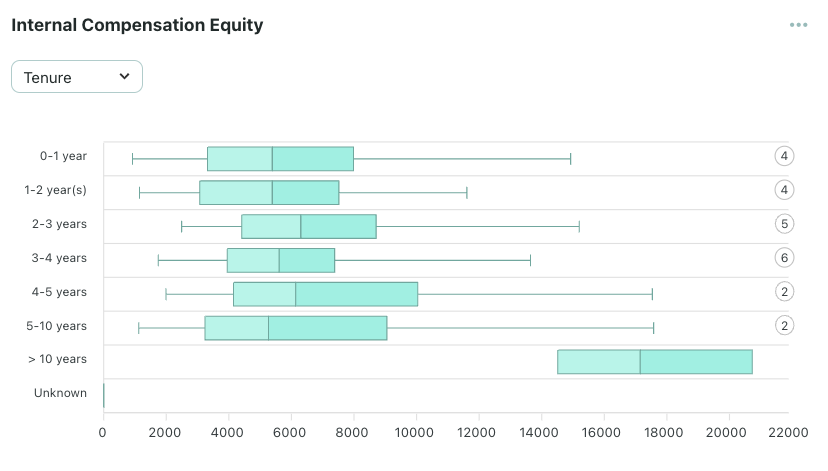
Inclusion
Finally, it’s important to understand the experience of your employees – do they feel a part of their teams and the organization?
Inclusion climate
One option is to measure the company’s inclusion climate. It will give you insights into how the employees perceive the organization’s environment and its policies, procedures, and practices. Is our company a place where all employees are and feel fully accepted? For example, do they feel part of informal discussions in their team, or do they have opportunities to influence organizational decisions?
You can also use surveys to measure employee well-being and satisfaction.
Employee well-being
Within employee well-being, you should look at:
- psychological safety,
- professional growth ability,
- peer support, and
- team learning behavior.
The dimension of employee well-being that is particularly useful to understand inclusion is environmental support. It refers to workplace-related factors that contribute to employees’ overall mental well-being:
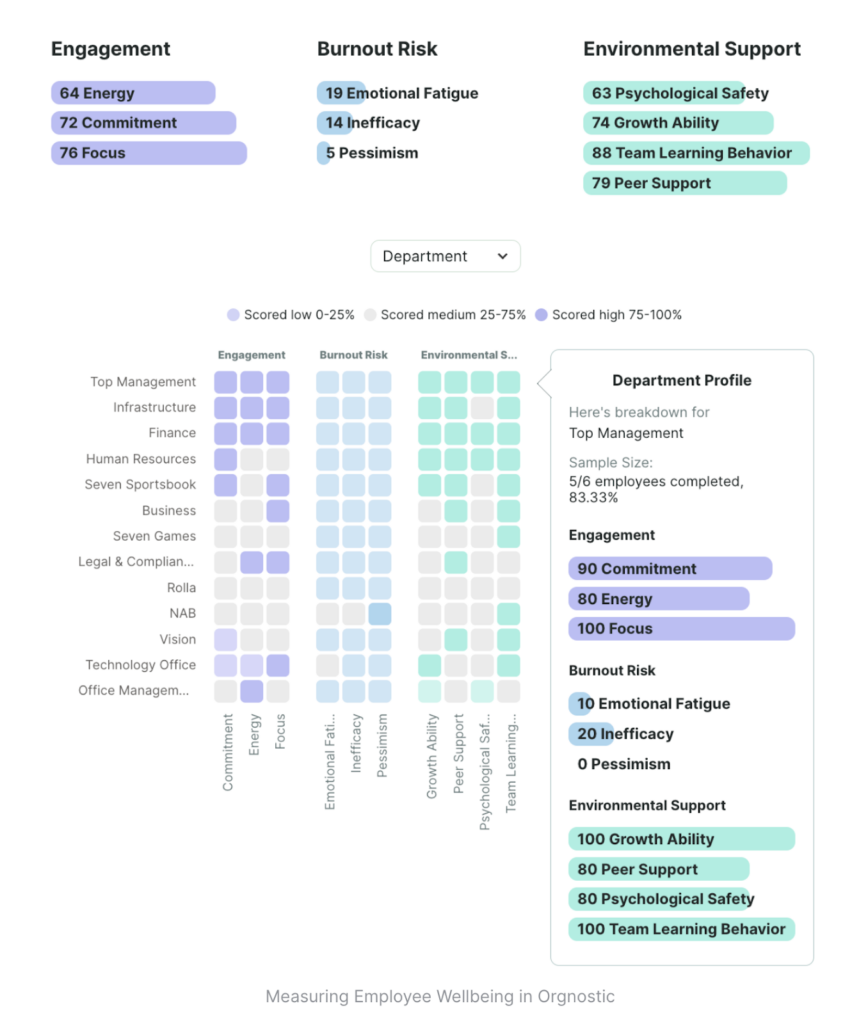
Two examples of indicators that help understand employee satisfaction are the Employee Net Promoter Score and Exit Reasons Distribution.
Employee Net Promotion Score (eNPS)
eNPS informs how likely your employees are to recommend your organization as a good place to work. It is expressed as a difference between the percentage of promoters and the percentage of detractors:
eNPS = % of promoters – % of detractors
To have a better understanding of the eNPS result, complement the numbers with employees’ qualitative comments about their satisfaction with the organization, job, and supervisor.
Exit Reasons Distribution
Exit Reasons Distribution helps you structure and understand the reasons for leaving the company reported by your former employees.
To be useful for analyzing DEI in the organization, the indicators such as the eNPS or Exit Reasons Distribution should be broken out for different groups of employees (according to their gender, age, ethnicity, and so forth). Lower satisfaction levels in certain groups may be a sign that we need to increase our DEI efforts.
2. Define the problem
Once you analyze your HR data, you can define the DEI problem or area of improvement. Remember to not limit your focus to the diversity indicators. Distribution metrics inform you about an imbalance in your workforce composition but do not explain why this imbalance occurs. Digging deeper into equity and inclusion measures helps you uncover the roots of the problem. Knowing the real cause of the DEI issues is essential for choosing effective DEI initiatives.
One method that is useful to understand your DEI challenges more in-depth is the Five Whys technique. It helps uncover the root cause of a particular problem by asking “why” five times. Here is an example of applying the Five Whys to analyze a DEI problem:
“The number of hired women is lower than the number of hired men.”
→ Why? “The ratio of women applicants that move from the first to the final interview is lower, compared to men applicants.”
→ Why? “The interviewers use unstructured interviews and may make biased decisions.”
→ Why? “They are not aware of their own biases.”
→ Why? “They were not trained on how to minimize bias in selection.”
→ Why? “This training has not been mandatory for the interviewers.”
Using insights from the analysis of your HR data to answer the “Whys” is a powerful method to uncover factors that underlie DEI challenges. In turn, having clarity on what are the roots of the problem is crucial to developing an effective DEI strategy.
3. Design the DEI strategy
Start designing your DEI strategy by setting the goals that you want to achieve. Make sure that your goals are SMART: specific, possible to measure, achievable, relevant for the organization and for the employees, and time-bound. Choose the KPIs to measure progress made towards your goals.
Think about activities that would help you achieve the targets that you defined. Obviously, the initiatives should be crafted for your specific needs and resources. However, certain activities are considered to have an overall positive impact on DEI at the workplace and are worth recommending. For example, to improve DEI in hiring you can use structured interviews together with general mental ability (GMA) tests. A number of studies showed that the combination of the two works well to predict job performance, and helps minimize bias in selection.
Flexible work arrangement is another example of an effective DEI initiative. It is particularly helpful to increase gender equality in the workplace. Studies confirm that, compared to men, women tend to dedicate more time to family activities, yet the same time to work. Therefore, flexible work arrangement helps female employees to better cope with professional and family responsibilities.
4. Implement DEI initiatives
Implementation is crucial for the success of your DEI strategy, and it is a different challenge altogether. Implementation includes many “pieces and parts” that are key for a positive result of the new initiatives. In this post, we don’t discuss the “implementation nuts and bolts”. However, we share some examples of aspects important to clarify when implementing new initiatives in organizations:
- What is the desired outcome of the initiative?
- How to communicate our goals to stakeholders?
- Who is involved in the implementation and how? Who are the end users? Who is leading and executing the implementation?
- Is any training or preparation required?
- How will we monitor and measure implementation progress?
5. Evaluate the outcomes
The last step of the process is evaluating the success of the implemented strategies. Compare your KPIs before and after implementing the new DEI initiatives.
You should also periodically review and adjust your goals. Keep an eye not only on the KPIs, but also on other DEI metrics, so you can diagnose new challenges that may arise.
Conclusion
Organizations should be constantly working toward diversity, equity, and inclusion. Designing a successful DEI strategy takes time and effort. However, following a clear, comprehensive process, and using organizational data and analytics is a formula to effectively improve DEI in our organization.
Want to run your DEIB initiatives on data and make an impact? 👉 Start your people analytics journey →
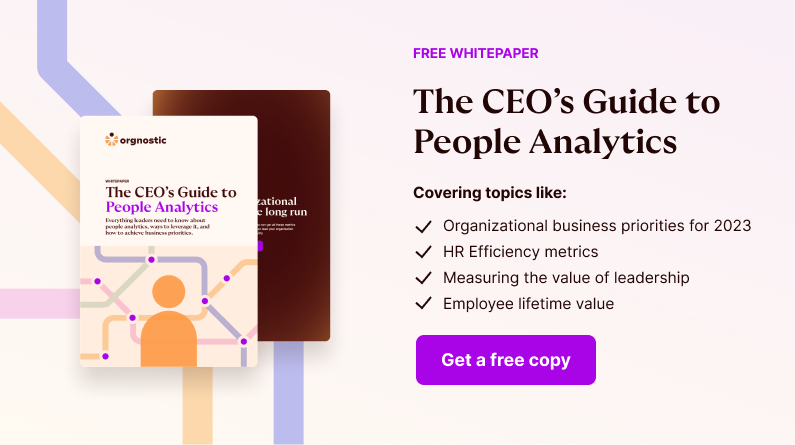
From the Diversity, Equity, and Inclusion series:
- Do All Employees in the Same Roles get Equal Compensation?
- How Many Critical Hires That We Make Are Women and Minorities?
- Are Women and Minorities Promoted as Often as the Rest?
- What Is the Diversity Breakdown of Our Top Performers and High-Potential Employees?
- What Is the Distribution of Women and Minorities Across Job Levels?